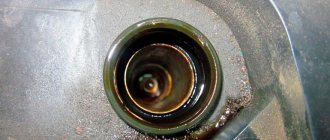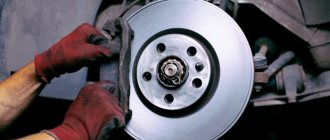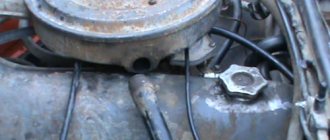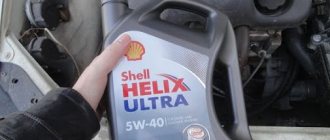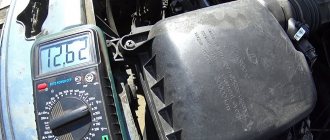It is well known that the engine and its systems have various seals and gaskets in their design, which provide the necessary seal at the junction of individual parts and elements. This seal allows the joints to be sealed, which prevents the leakage of engine oil and other technical fluids.
At the same time, during the operation of the car, the owner may quite often encounter the fact that the oil still begins to leak. In some cases, the lubricant actively pollutes the engine from the outside, oil gets into the spark plug wells, flows out from under the oil filter, camshaft or crankshaft seals leak, etc.
We also recommend reading the article about why oil leaks from under the oil filter. From this article you will learn about the causes of such oil leaks, as well as the available methods of troubleshooting.
It is important to understand that oil leaks not only lead to increased consumption of lubricant and pollute the internal combustion engine, but also cause various malfunctions, that is, they affect the operation of the engine. One of these common problems is considered to be the problem when oil is found in the spark plug wells. Next we will talk about the reason for oil getting into the spark plug wells, as well as how to fix such a leak with your own hands.
Oil in spark plug wells: cause of malfunction and possible consequences
Note that the appearance of oil in the area of the spark plug well is quite common on different internal combustion engines. Next, we will look at the problem using the example of 16-valve engines that are installed on the domestic Lada Priora model.
It should be separately added that such a problem can arise both on used cars and on practically new ones. In this case, this malfunction should be corrected immediately, since oil getting into the wells can lead to more serious complications.
If oil is present in the spark plug well, then this leads to softening of the rubber elements (spark plug insulator, high-voltage armored wires). As a result, spark breakdowns, cylinder misfires occur, the engine starts poorly, stalls, and loses power. In the future, various elements of the ignition system (coil, spark plugs, etc.) may fail.
We also recommend reading the article about why misfires occur. From this article you will learn about possible causes of the malfunction, as well as ways to diagnose and solve this problem.
Such failures can cause the engine “check” to light up on the dashboard, the engine requires constant computer diagnostics and error reset, not to mention the reduced service life of the spark plugs themselves, explosive wires and other parts.
So let's get back to the reasons. To begin with, oil usually enters the spark plug wells through leaks in the valve cover gasket area or through the spark plug well seals. On many engines, a rubber gasket is installed under the valve cover for sealing, and various types of sealants (anaerobic, silicone, etc.) have also recently become widespread.
Oil leaks often occur on internal combustion engines, where the valve cover is initially seated only on a sealant. In other words, the manufacturer itself does not provide for the installation of a rubber gasket in order to simplify and reduce the cost of the overall design.
Gradual drying of the sealant, errors in its application, as well as the use of low-quality compounds lead to the fact that such a seal begins to leak, much faster than a conventional gasket. Owners of the Priora model noted cases when oil appeared in the spark plug wells even on new cars. The fact is that during the long period of inactivity of the car in the car dealership, the sealant simply had time to dry out.
Detailed description of replacement
Installing new sealing elements for spark plug wells involves preparing spare parts and tools. If you decide to put new parts into the old cover yourself, then the procedure boils down to:
- valve cover removal
- removing old seals
- installation of new ones.
You will need a hammer, screwdriver, pliers, drill or engraver, automotive sealant (gray or red), a set of sockets and a wrench.
Spare parts for replacement on the QG15DE motor
For work you will need the following spare parts - four camshaft oil seals from the VAZ "nine", a valve cover gasket (article 13270-4M500). To coincide with the replacement of spark plug well seals, you can install a new valve for ventilation of crankcase gases (article 11810-0M300), together with gaskets - under the valve itself (11812-41B00) and ventilation (13271-4M501).
If you doubt your abilities, then you can buy a new valve cover for the Nissan QG15DE engine, its article number is 13264-4M502. The installation will eliminate the troublesome task of dismantling and replacing consumables.
The new cover is expensive, but you don’t need to cut anything out
Removing the valve cover
The preparatory stage involves dismantling the valve cover of the Nissan QG15DE engine. The procedure must be performed in a certain sequence. First, the electrical wiring connectors for the ignition coils are removed, then the coils themselves are carefully disconnected.
The screws are unscrewed strictly in accordance with the diagram, but only in the reverse order. The removed gaskets and crankcase gas valve are discarded.
Removing old and installing new oil seals
After completing the procedure, the QG15DE engine needs to be covered with something (paper towels or felt will do) to prevent the ingress of dust and dirt. Old oil seals are removed from their seats by drilling and carefully prying them off with a screwdriver. The main thing is not to damage the fragile plastic panel, otherwise you will have to install a new valve cover. A good result can be achieved using an engraver with attachments.
After removal, the seats are degreased. Galosh gasoline is suitable for this, but not fuel from a gas station (due to the presence of more than gasoline in it) or acetone.
Replacing spark plug well seals on QG15DE is done using automotive sealant, which generously lubricates the socket itself and the sealing element. Excess sealant can be easily removed with a paper towel that does not leave lint. Once everything is in place, the motor part needs to be brought into a warm room to dry. In this matter, you should follow the instructions of the sealant manufacturer.
In addition to changing the spark plug well gaskets, you can change the crankcase gas valve, valve gasket and crankcase ventilation gasket. Hardened gaskets are unable to cope with their task, especially when it comes to cars with high mileage.
Self-fixing oil leaks in spark plug wells
Taking into account the above information, it becomes clear that for normal operation of the ignition system, even a minor leak that leads to oil accumulation in the well area must be eliminated. However, not all drivers know what to do if there is oil in the spark plug wells. Let's look at how to remove oil from spark plug wells and make such repairs yourself.
Let us immediately note that although this procedure is not complicated, without certain skills it will still be correct to contact a service center and entrust the car to specialists. If you solve this problem yourself, then you will need:
- remove the intake manifold;
- remove the timing belt casing;
- remove the timing belt;
- remove the valve cover;
- remove the camshaft from the bed;
These works will allow you to gain free access and fully remove the old layer of sealant from elements and surfaces, as well as efficiently apply a fresh compound. Please note that it is imperative to completely remove the old sealant. Any residues may interfere with subsequent sealing of parts using the new composition. In this case, the entire complex of work will need to be carried out again.
In this case, it is necessary to remove the old layer of sealant carefully, that is, do not use sharp hard objects or abrasives. The fact is that the appearance of scratches and burrs on the mating surfaces can lead to the fact that even after applying fresh sealant it will not be possible to achieve tightness after joining the parts.
As a result, the oil leak will continue, additional air leaks may appear, etc. For this reason, the old sealant is removed with chemical solvents. For this, use acetone, white spirit or regular gasoline. A small piece of cloth is soaked in a solvent, after which the surface is thoroughly wiped off to remove the old sealing compound.
Fresh sealant is then applied to the surface of the valve cover and reassembled. As for the sealant itself, the best option for these purposes is an anaerobic sealant. During assembly, it is also important to consider the order and tightening torque of the mounting bolts when installing the valve cover.
Replace spark plugs! (difficult for VQ23DE and VQ35DE.)
Has anyone had any experience with replacement? Before the cold weather sets in, I’m thinking of playing it safe and replacing it! Officials have an original with platinum tips for about 650 rubles (we multiply 650 by 6 to get 3900), however! Also an alternative to spark plugs from NGK, platinum 450 RUR, iridium 350 RUR, copper 90 RUR! Who put the opinions to the studio. Also regarding work: to replace the rear spark plugs, you need to remove/install the manifold, approximately how much money should you prepare for this procedure?
I changed the spark plugs yesterday. I installed the usual ones. In the store there are iridium ngk 450, regular denso 250. I took the regular ones. I decided to change it more often. What is the point of platinum or iridium ones if they do not wear out and the interruption in operation occurs due to contamination of the spark plugs themselves from low-quality fuel. Once you fill up with shit, you can throw away such candles. Clean them, then screw them in again. Isn't it easier to install regular ones? In general, IMHO everything is fine. But that's what I decided. I will change the spark plugs every 10,000 km using the ones that are available. And every 20,000 km - a complete replacement with removal of the manifold. You can change 4 candles yourself in 30 minutes. That's exactly what I did. There is nothing complicated. Take a ratchet wrench with a 10 mm head and unscrew the coils. Then you unscrew the spark plugs with a spark plug wrench. I unscrewed the 3 spark plugs that are closer to the front of the engine easily, but to unscrew the 4th spark plug (on the right, at the rear of the engine) I had to buy a shorter key, because... The length of the spark plug wrench tube did not allow me to do this.
Useful tips
As you can see, replacing the sealant under the valve cover is not a complicated procedure. The main requirements include thorough cleaning of the old layer and proper application of fresh sealant to the surface.
The applied layer must be even and no interruption is allowed. It should also be noted that the sealing compound must also be used to treat the joints between the connections of the spark plug wells, having previously removed the old sealant from there.
Let us add that these areas, as a rule, are generously covered with a sealing compound, which will require some effort to fully clean such surfaces. To process the connections of the spark plug wells, a special red sealant is used, which can be purchased at car dealerships.
If only one engine needs to be repaired, then it will be enough to purchase a small tube of heat-resistant sealant. You can also read about selecting the best sealant for the engine in our separate article.
It should be noted that the use of sealant if the valve cover on a particular internal combustion engine is installed through a rubber gasket is undesirable. In this case, it is necessary to purchase a new high-quality gasket, after which the mating surfaces are checked. Next, the new valve cover gasket is installed in place, after which the valve cover is tightened, taking into account the order and torque of the fasteners.
Choosing a sealant for spark plug wells
dimmaster wrote: I don’t quite understand the topic, you say sealant for wells and refer to the thread lock for spark plugs.
or did I misunderstand your point? So it’s written there, CYLINDRICAL UNIT RETAINER, so choose it)
so these seem to be not sealants, but thread lockers, I think they are only for threads, they are distinguished by their ability to be “high-strength”, the weakest green is then blue and the strongest is red, oh, I didn’t see about green) sorry
Edited by Letty (02/09/2014 17:34)
So I’m wondering: sealant = retainer or not, is it also necessary for cylindrical connections or can it be used for threads. I don't know, maybe they have completely different properties
Apart from the green one, these fasteners are needed to seal the threaded connections (prevent the nuts from coming loose), but if there is a specific one for cylindrical ones, I just don’t understand how it differs from conventional sealants
Letty, by name, I guess)) But seriously, the usual anaerobic sealant in a car is 49,500 rubles for 50 ml.
Any sealant for injection internal combustion engines. Not to be confused with thread locker. If you overdo it for threading, you will unscrew it only with a torch, and without it you will break the pin. I use ABRO - gray (this is the color).
masiy, this one?
those. Any good silicone sealant will do? Can we forget about anaerobic??
It doesn't smell like vinegar and is pleasant to work with.
There is also a red Abro for the exhaust manifold - I installed my manifold on it, everything is super :)
Mega-ZZZ, that’s why I’m asking)) My task is to install a spark plug well. Any heat-resistant sealant (ABRO for example) will suit me, or it can be fundamentally anaerobic or not, gray or red, for screw connections or for cylindrical ones))))
dimmaster, not fundamentally, anyone is not even heat-resistant, because there is no such temperature there, no more than 120 degrees, and even one that is not heat-resistant holds up to 300.
Mega-ZZZ, why then, after voicing the purpose of the sealant, does everyone sing “anaerobic” like a mantra))) why is it so good?
Actually, by googling the question, you can draw your own conclusions for each specific purpose :)
What's the result?
- As a rule, it is possible to solve the problem of oil in spark plug wells with minimal financial costs. Even if you purchase an expensive professional sealant, the price of a small tube remains quite affordable.
After removing the oil from the wells, replacing the spark plugs and high-voltage wires may also be necessary to restore normal engine operation. The reason may be that the oil in the wells quickly softens and damages the rubber insulation.
- We would like to add that in some cases it is not necessary to change the spark plugs at the initial stage, but it may be necessary to clean the spark plugs separately. Only after removing dirt and carbon deposits will the power unit operate stably and smoothly.
- If mistakes were made during the application of the sealant, then the oil leak may continue in the future. For example, anaerobic sealants only cure when there is no contact with air. It turns out that if it is not possible to achieve a tight fit of the surfaces, then the composition will remain liquid and the seam will not be sealed.
What does this mean?
If nothing is done, then spark plug wells in oil along the chain will very soon cause a series of unpleasant events. Thus, due to the effect of oil on the rubber insulators of explosive wires, a breakdown may occur over time, which will lead to unstable engine operation, as well as the need to change spark plugs more often.
